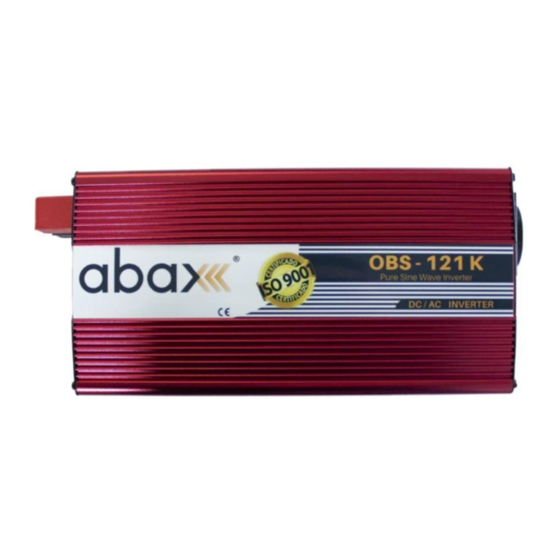
Table of Contents
Advertisement
Quick Links
Advertisement
Table of Contents

Summarization of Contents
Models and Denotations
Model Naming Convention
Explains the structure of product model numbers, including power and waveform type.
Safety First
Shock Hazard and Opening Warnings
Covers risks of electric shock, keeping away from children, and avoiding foreign objects in openings.
Heated Surface and Clearance Precautions
Alerts to high surface temperatures and the necessity of maintaining adequate air space around the unit.
Explosion Hazard Warnings
Warns about flammable gases from batteries and unsuitable locations or battery types.
Equipment Usage Cautions
Lists specific equipment types that should not be used with the inverter due to potential damage or hazard.
Product Features and Applications
Key Product Features
Details technical features such as soft start, PWM, microprocessor design, and protection mechanisms.
Recommended Product Applications
Outlines the inverter's suitability for various power tools and household appliances.
Guidelines
Installation Conditions
Specifies environmental requirements for safe and optimal inverter placement, including dryness and temperature.
Working Principle Explained
Describes the two-stage DC to DC conversion process and AC output generation.
DC Connection Method
Details how to correctly connect DC input terminals, emphasizing polarity and potential damage from reverse connections.
Connection Safety and Grounding
Covers safe connection practices like avoiding sparks, securing terminals, and proper grounding procedures.
Battery Charging Recommendations
Advises on using deep cycle batteries and responding to low voltage alarms for optimal battery life.
Inverter Operational Status
Explains power indicators and the procedure for connecting and operating AC appliances with the inverter.
Operating Precautions and Auto-Shutdown
Details auto-shutdown triggers, input voltage limits, fan operation logic, and important notices.
The Sketch of Inverter
3000W Model Component Identification
Identifies the ports, indicators, and features of the 3000W pure sine wave inverter.
1000W Model Component Identification
Identifies the ports, indicators, and features of the 1000W pure/modified sine wave inverters.
2000W Pure Sine Wave Model Identification
Identifies the ports, indicators, and features of the 2000W pure sine wave inverter.
2000W Modified Sine Wave Model Identification
Identifies the ports, indicators, and features of the 2000W modified sine wave inverter.
1500W Model Component Identification
Identifies the ports, indicators, and features of the 1500W pure/modified sine wave inverters.
600W Model Component Identification
Identifies the ports, indicators, and features of the 600W pure/modified sine wave inverters.
300W Model Component Identification
Identifies the ports, indicators, and features of the 300W modified sine wave inverter.
Inverter to Battery Connections Details
2000W to Battery Connection Diagram
Illustrates the wiring diagram for connecting a 2000W inverter to a 12V battery, including the DC fuse.
Trouble Shooting
No Power or Green Indicator Off
Lists causes and solutions when the inverter does not power on or the green indicator is not lit.
Red Fault Indicator Active
Lists causes and solutions when the red fault indicator is illuminated, indicating an operational issue.
Battery, Ventilation, and Current Issues
Addresses problems related to battery discharge, overheating due to poor ventilation, and excessive input current.
Low Output Current Diagnosis
Explains how to troubleshoot low measured output current, including ammeter range considerations.
Inverter Alarm Sound Troubleshooting
Lists causes and solutions for various alarm sounds emitted by the inverter, such as low voltage or over temperature.
Warranty
Limited Warranty Terms and Coverage
Details the warranty period, coverage for manufacturing defects, and requirements for proof of purchase.
Warranty Exclusions and Limitations
Lists specific conditions, actions, or damages that are not covered by the product warranty.


Need help?
Do you have a question about the OBS-1206 and is the answer not in the manual?
Questions and answers